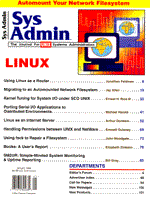
Listing 1: sysmon.sh--the system monitor
#!/bin/sh # # sysmon - system monitor. # # SYNOPSIS # /usr/local/etc/sysmon [init | cont | sked] # # DESCRIPTION # Maintains downtime/heartbeat/incident logs for calculating avail- # ability. Normally called from cron(8). # # OPTIONS # init Emit an incident record (line) to the current daily log # file. Normally called near the end of rc.local to indi- # cate the time the system came back to life. An incident # record has the format: # # - yyyy mm dd hh mn ss # # where: # yyyy -- year (AD) # mm -- month (01 - 12) # dd -- day (01 - 31) # hh -- hour (00 - 23) # mn -- minute (00 - 59) # ss -- second (00 - 59) # # cont Emit a heartbeat record to the current daily log file. # This is the default. A heartbeat record has the format: # # + yyyy mm dd hh mn ss # # sked Emit a scheduled downtime record: # # * yyyy mm dd hh mn ss # # Normally, sysmon isn't called to do this. After sched- # uled downtime, the sysadmin should edit current daily # and insert a "*" for "-" in the last incident record. # # FILES # Unless otherwise indicated, all files reside in LOGROOT, and # All temporary files reside in /tmp. # # D.yyyy.mm.dd -- A daily log. If yyyy.mm.dd is today's date, # the log is active. # # A daily log record has the format documented above (OPTIONS). # In addition, it may contain arbitrary comment lines, indi- # cated by a "type" field of "#". # # M.yyyy.mm -- A monthly log. # # Y.yyyy -- A yearly log. # # sysmon.$$.* -- Temporary files; always removed by the script. # # LOKFILE -- If it exists, the daily log is locked; no # other process should fiddle with them. Its # content is the name of the locked file. # Installation constants #set -x HIWATER=5000 LOGDIR=/var/log LOGROOT=$LOGDIR LOKFILE=$LOGROOT/sysmon.LOCK # # Direct paths to programs used CUT=/bin/cut DATE=/bin/date ECHO=/bin/echo RM=/bin/rm # # Begin. # # # Set the date parameters. $DATE '+%y %m %d %H %M %S' > /tmp/sysmon.$$.date YY=`$CUT -d' ' -f1 /tmp/sysmon.$$.date` MM=`$CUT -d' ' -f2 /tmp/sysmon.$$.date` DD=`$CUT -d' ' -f3 /tmp/sysmon.$$.date` HH=`$CUT -d' ' -f4 /tmp/sysmon.$$.date` MN=`$CUT -d' ' -f5 /tmp/sysmon.$$.date` SS=`$CUT -d' ' -f6 /tmp/sysmon.$$.date` $RM -f /tmp/sysmon.$$.* YY=`expr $YY + 1900` # # Do according to command line parameters -- usually just sets # the type of record to be emitted. case "$1" in cont) CC="+" ;; init) CC="-" $RM -f $LOKFILE ;; sked) CC='*' ;; * ) CC="+" ;; esac # # Set file name. FN="D.$YY.$MM.$DD" # # Attempt to lock. if [ -f $LOKFILE ] then # # File already exists; something is terribly wrong. Quit. exit 1 else $ECHO "$FN" > $LOKFILE fi # # Emit record. $ECHO "$CC $YY $MM $DD $HH $MN $SS" >> $LOGROOT/$FN $RM -f $LOKFILE # # Normal termination exit 0
|